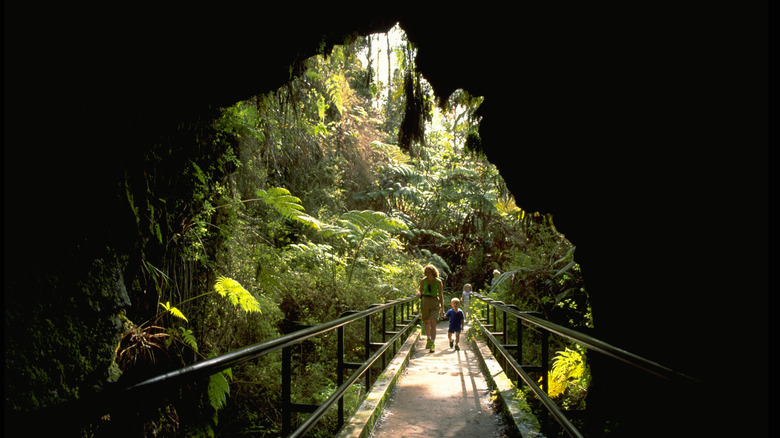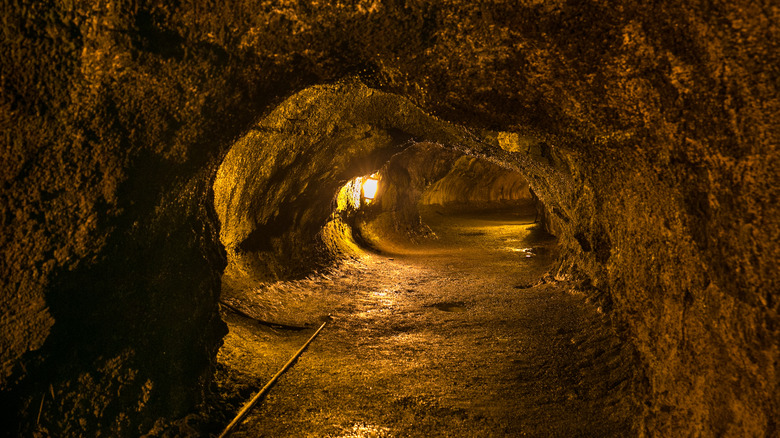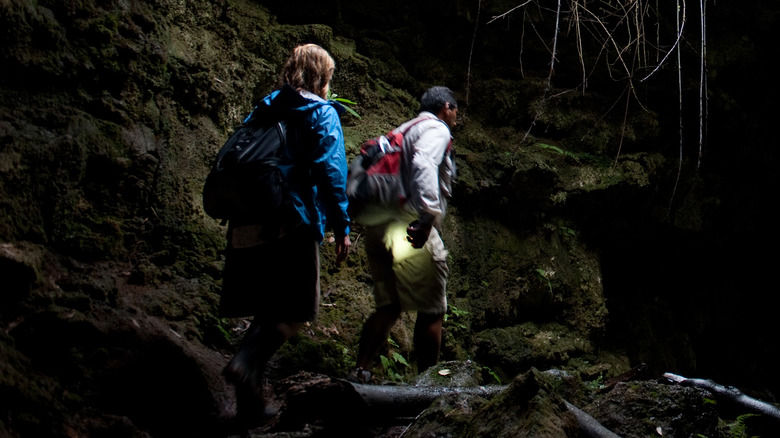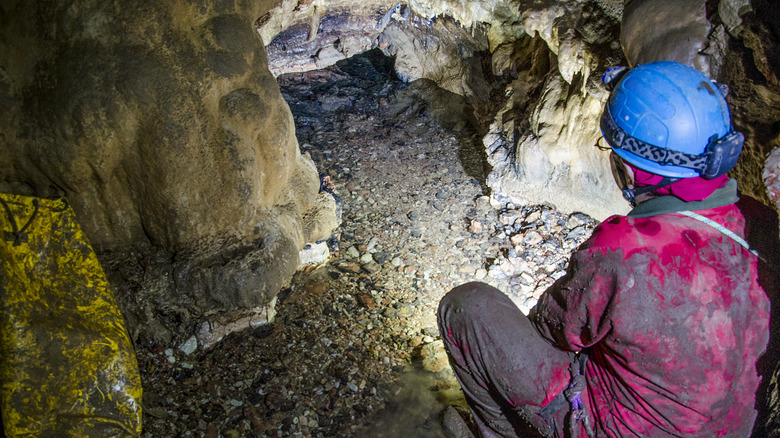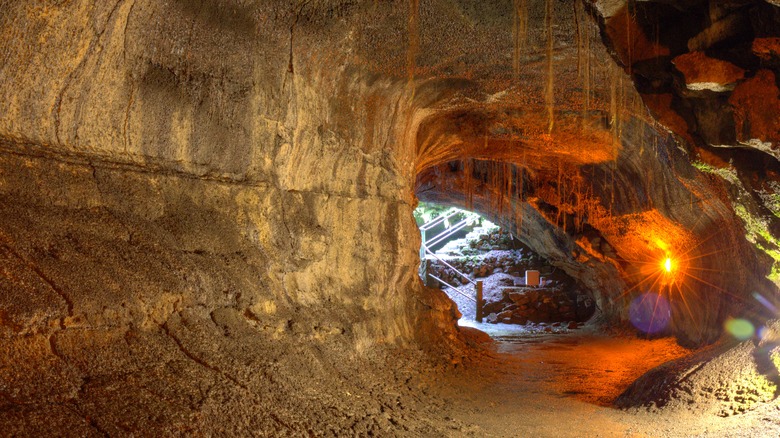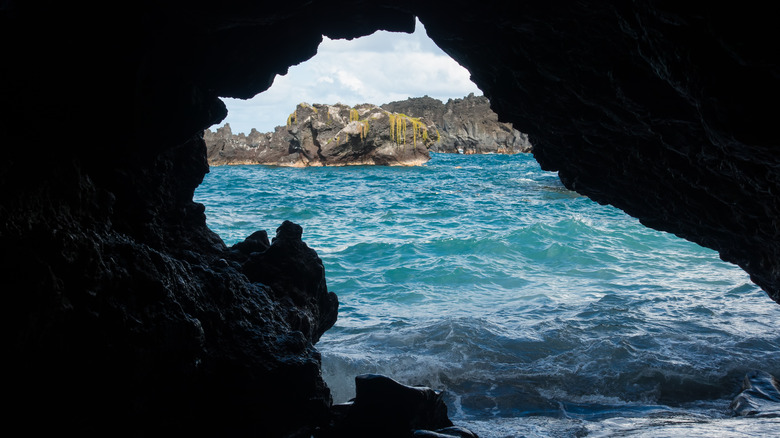Lava Tubes Are The Underrated Attractions You Shouldn't Skip In Hawaii
Hawaii is well-known for its picturesque beaches, towering waterfalls, and verdant terrain, all made possible by a string of volcanoes that continuously change the scenery. While it's easy to focus on the above-ground attractions in this tropical paradise, there's a whole other world just beneath the surface. Hawaii's network of lava tubes is a fascinating destination in and of itself.
These pyroducts, as they are scientifically named, are formed by rivers of lava that reach temperatures of more than 2,000 degrees Fahrenheit when a volcano is active, says the National Park Service. Once the volcano erupts and drains the tunnels, what remains is an underground network of caves. Years after the rocks cool, a whole new ecosystem emerges. These empty tunnels become home to troglobites, or small organisms that are adapted to life in the dark, like small fish, shrimp, and salamanders. If you're feeling brave enough to go cave spelunking, the lava tubes will give you a whole new appreciation for Hawaii.
Nāhuku (Thurston)
The Nāhuku lava tube on the Big Island is a popular free and self-guided tourist attraction that's easy to get to and explore. Formerly known as Thurston, the tube was later renamed to Nāhuku as part of Hawaii's initiative to give landmarks indigenous names. When this 500-year-old cave was discovered in 1912, it was covered in black lavacicles, a lava tube's version of spiky stalactites that hang from the ceiling. Eventually, tourists took them all home, but the details that remain still offer a fascinating glimpse into the past.
With smooth ground, interior lighting, and a ceiling that reaches 20 feet tall at times, this tube is probably the least hair-raising for claustrophobics. Visitors can access the lava tube by visiting Hawaii Volcanoes National Park. The entrance is an easy walk from the parking lot by Chain of Craters Road. The tube is open 24 hours a day, though it's only lit inside from 8 a.m. to 8 p.m. After that, you'll need to bring a flashlight or a headlamp.
Kazumura
At more than 40 miles long and 3,600 feet deep, the Kazumura lava tube system on the Big Island is believed to be the longest and deepest in the world. It was formed roughly 500 years ago in the Ailāʻau eruption from the Kīlauea volcano, an event which spanned 50 years. In native Hawaiian culture, Kīlauea is said to be home to Hawaii's volcano and fire goddess, Pele.
The entrance of the lava tube system, now called Kazumura Cave, was discovered in 1995. A man named Harry Schick bought a property and heard from the previous owner that there was a cave nearby. He didn't believe it until a cave surveyor confirmed it. He cleared the entrance and started exploring. Today, he has surveyed 60% of the cave and offers tours via his website Kazumura Cave Tours. There are three tours available that range from moderate to advanced: a two-hour tour to Lava Falls ($50), a four-hour tour to the Pit Room ($100), and a six-hour tour known as the Maze, which is reserved for experienced cave explorers ($150). Since Kazumura is located on private land, booking a tour is the only way to have this unforgettable experience.
Kula Kai
On the south side of the Big Island, another adventure awaits. Kula Kai is an extensive lava tube system beneath Mauna Loa, the largest volcano in the world. Guided tours of this 1,000-year-old tunnel are required and available by reservation only through Kula Kai Caverns, ranging from a one-hour lighted tour ($28) to a two-hour trek ($95) that requires full gear with helmets, knee pads, and gloves. If your nervous system can handle it, "the crawl" tour ($60) will have you literally crawling on your hands and knees through a narrow passage to view unusual rock formations and lava balls — truly something original to add to your Hawaii bucket list. No matter which tour you choose, a guide will bring the history and geology of this mysterious labyrinth to life.
To enjoy this trip, visitors should feel comfortable with tight spaces, walking on uneven surfaces, and going up and down ladders. While the lighted tour is family-friendly, the more advanced tours are not suitable for children under the age of five. Since the tours operate in a small group format, they tend to book out quickly. Be sure to call ahead of your trip and reserve your spots in advance.
Ka'eleku
Maui's famous road to Hana will keep you busy all day. While you're out and about enjoying the scenic vistas above the ground, don't forget to venture a little bit below it. Exploring the Ka'eleku Caverns, also known as the Hana Lava Tubes, is a family-friendly activity off Ulaino Road just past Marker 31. After a short orientation at the visitors center, you'll enter the 960-year-old lava tube through a "skylight," which is a portion of the ceiling that collapsed. As you venture deeper on a self-guided tour, you'll find unusual rock formations like lavacicles, fissures, and cracks. There are even portions of the rock that look like dripping brownie batter, which the kids will love.
The caves are open from 10:30 a.m. to 4 p.m. every day of the year. Tickets cost $15 per person and kids under the age of five can get in for free. Plan for about 40 minutes to explore the cave, which is relatively easy and accessible with features like handrails. Once you're back on regular terra firma, try your luck at getting through a maze made of bright pink ti plants, an extra perk included with the cost of admission.
Waiʻānapanapa
Of all the lava tubes on this list, the tunnel at Waiʻānapanapa State Park is the most photogenic. Also on the Road to Hana, this lava tube spills out to the sea of a black sand beach on Honokalani Road, just past marker 32. It's an easy tube to access from the parking lot and less stress-inducing for people with claustrophobia, provided that you can walk down the bottom of the stairwell and crouch near the entrance. Once you're inside the tube, keep walking forward for a spectacular view of the ocean.
To visit Waiʻānapanapa, reservations are required through the state park website. Admissions costs $10 per car, plus $5 per person after that. Visitors are only allowed to enter in 3-4 hour time blocks from 7 a.m. to 6 p.m. To beat the crowds, get there as early as you can, as the black sands are a popular tourist draw. Also be sure to wear non-slip shoes, as the ocean waves can make the rocks slippery. While there are countless lava tubes to explore on the islands of Hawaii, there's no doubt that this one makes a stunning grand finale.
